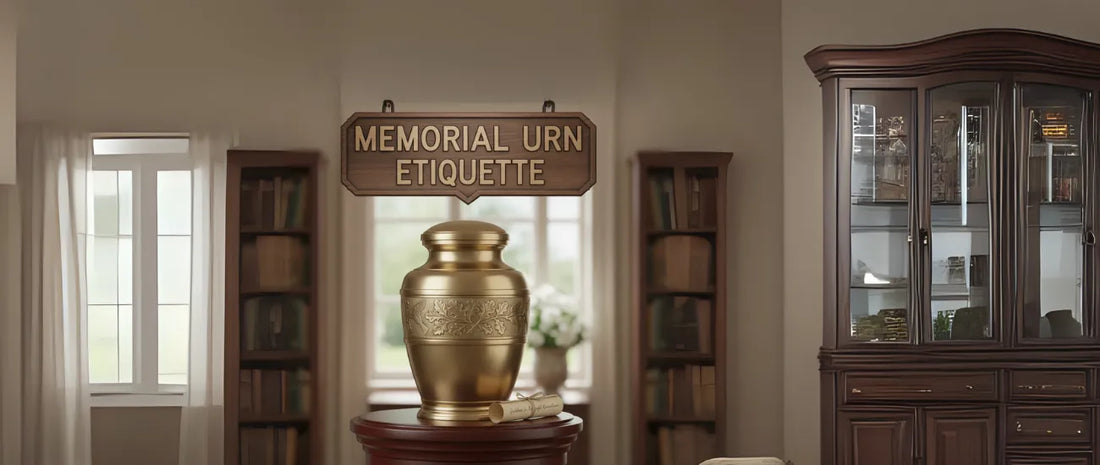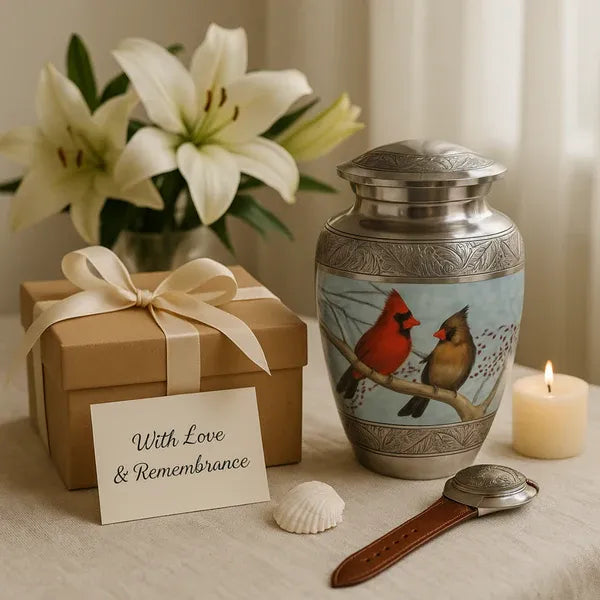Memorial Urn Etiquette: Answering Common Questions with Sensitivity

Navigating the world of memorial urns can feel overwhelming, especially during a time of grief. Many families have similar questions about proper etiquette, care, and customs surrounding cremation urns. Whether you've chosen from our metal urn collection, our wooden option, or our aluminum urn with wooden finish, this guide addresses the most common concerns with the sensitivity and respect this topic deserves.
Displaying Memorial Urns at Home
1. Is it appropriate to keep an urn at home?
Absolutely. Many families find great comfort in keeping their loved one's remains close. There are no legal restrictions against keeping an urn in your home, and it's a personal choice that should be made based on what brings your family peace. Home display allows for daily connection and makes the memorial part of everyday family life.
2. Where should an urn be displayed?
Choose a location that feels respectful and meaningful to your family. Popular locations include:
-
Living room mantel or shelf: A central location where family naturally gathers
-
Entrance hallway: Where your loved one's presence greets family and visitors
-
Bedroom or study: More private spaces for personal reflection
-
Family room: Part of the everyday living environment
-
Dining room: Where family meals and conversations take place
-
Home office: A quiet space for contemplation
The key is selecting a spot that feels dignified and provides comfort to your family while being practical for your daily routine.
3. Should the urn be covered or protected?
This is entirely a matter of personal preference. Some families choose to display their urn openly as part of their home décor, while others prefer additional protection:
-
Glass domes: Protect from dust while keeping the urn visible
-
Display cabinets: Provide protection while creating a dedicated memorial space
-
Fabric covers: Some families use decorative cloths for special occasions
-
Natural display: Many urns are designed to be displayed without additional covering
Consider your home environment, the presence of pets or children, and your family's comfort level when making this decision.
Handling and Care Guidelines
Can family members touch or move the urn?
Yes, it's perfectly acceptable for family members to handle the urn when done respectfully. Some families find comfort in this physical connection. However, it's important to establish family guidelines:
-
Gentle handling: Always use both hands and move slowly
-
Clean hands: Ensure hands are clean and dry before touching
-
Family agreement: Decide who may handle the urn and when
-
Special occasions: Some families reserve handling for meaningful moments
-
Children's involvement: Teach young family members appropriate respect and handling
How should different urn types be cleaned?
Each material requires specific care approaches:
Metal Urns:
-
Dust regularly with a soft, dry cloth
-
Use appropriate metal cleaner occasionally to maintain finish
-
Buff gently to restore shine on polished surfaces
-
Handle normal contact without concern for damage
Wooden Urn:
-
Dust with soft cloth following wood grain direction
-
Use wood-appropriate cleaners sparingly
-
Apply wood conditioner periodically to maintain finish
-
Handle with extra care to preserve natural beauty
Aluminum with Wooden Finish:
-
Simple dusting with soft cloth maintains appearance
-
Can handle slightly damp cleaning if needed
-
No special treatments required
-
Most durable for regular family interaction
What if the urn gets damaged?
Don't panic if minor damage occurs. Focus on the memories and meaning rather than perfect physical condition:
-
Minor issues: Small scratches or marks often add character over time
-
Professional repair: Many types of damage can be professionally restored
-
Family perspective: Remember that love and memories are what truly matter
-
Learning opportunity: Use incidents to teach family members proper care
-
Insurance consideration: Document valuable urns for potential coverage
Social Situations and Visitors
Should I mention the urn to guests?
This is entirely personal and depends on your comfort level and relationship with visitors:
-
Close family and friends: Often appreciate knowing about your memorial display
-
Casual visitors: May not need specific mention unless they ask
-
New acquaintances: Use your judgment about sharing personal information
-
Service providers: Brief, respectful explanation if they'll be working near the display
The key is doing what feels right for your family while being prepared to answer questions if they arise.
Is it okay to photograph an urn?
Family photographs including memorial urns are common and appropriate:
-
Family documentation: Natural to include memorials in family photos
-
Special occasions: Memorial urns often appear in holiday or celebration photos
-
Respectful approach: Treat memorial photos with same dignity as other family images
-
Guest consideration: Always ask permission before photographing someone else's memorial
-
Social media: Use discretion about sharing memorial images publicly
Children and Memorial Urns
How should children interact with urns?
Children can develop healthy relationships with memorial urns when guided properly:
Age-Appropriate Explanation:
-
Use simple, honest language about death and memorials
-
Explain the urn's significance without frightening details
-
Answer questions directly but gently
-
Allow natural curiosity while teaching respect
Teaching Respectful Behavior:
-
Demonstrate gentle handling and quiet behavior near the memorial
-
Explain why careful treatment is important
-
Include children in memorial care activities when appropriate
-
Create positive associations with remembrance and love
Encouraging Healthy Remembrance:
-
Allow children to share memories near the memorial
-
Include them in special memorial traditions or holidays
-
Let them contribute drawings or flowers to the display
-
Support their individual ways of processing grief
Should children be afraid of urns?
With proper explanation, children typically aren't frightened by memorial urns:
-
Focus on love: Frame conversations around love and remembrance
-
Natural process: Explain death as a natural part of life
-
Continuing connection: Help children understand ongoing relationships with memory
-
Individual responses: Some children may need more time or different approaches
-
Professional help: Consider grief counseling if children show significant distress
Travel and Transportation
Can urns be transported?
Yes, but with careful planning and appropriate precautions:
Packing for Safety:
-
Use secure, padded containers for protection
-
Ensure the urn cannot shift during transport
-
Consider professional packing for valuable pieces
-
Keep important documentation accessible
Transportation Considerations:
-
Car travel: Secure the urn to prevent movement during stops or turns
-
Air travel: Check airline regulations and use approved containers
-
Shipping: Consider professional services experienced with memorial items
-
Moving: Plan carefully for household relocations
Should urns be moved frequently?
Generally, it's best to minimize unnecessary movement:
-
Stability benefits: Permanent placement reduces risk of damage
-
Emotional comfort: Consistent location provides reliable memorial space
-
Practical considerations: Frequent moving increases chances of accidents
-
Special occasions: Moving for holidays or anniversaries can be meaningful
-
Household changes: Sometimes relocation is necessary for practical reasons
How do cultural backgrounds influence memorial practices?
Different cultures bring varying perspectives to memorial urns:
-
Family involvement: Some cultures emphasize extended family participation
-
Memorial timing: Various traditions around anniversary observances
-
Display customs: Different approaches to home memorial displays
-
Generational differences: Older and younger family members may have different comfort levels
-
Integration challenges: Blending different cultural approaches within families
Practical Etiquette for Different Situations
Memorial Services and Ceremonies
If your urn will be present during memorial services:
-
Coordination with funeral home: Ensure proper handling and transport
-
Display during service: Plan appropriate placement and protection
-
Family handling: Designate who will manage the urn during events
-
Post-service plans: Arrange for safe transport home after ceremonies
Holiday and Anniversary Observances
Many families develop traditions around memorial occasions:
-
Special decorating: Adding seasonal elements to memorial displays
-
Family gatherings: Including memorial acknowledgment in family events
-
Gift traditions: Some families place flowers or cards near urns on special dates
-
Moment of silence: Brief remembrance during family celebrations
-
Storytelling: Sharing memories as part of holiday traditions
Creating Positive Memorial Experiences
Building Family Traditions
Memorial urns can anchor meaningful family customs:
-
Regular remembrance: Weekly or monthly memorial moments
-
Special occasion inclusion: Including memorial in family celebrations
-
Shared care: Family activities around memorial maintenance
-
Story preservation: Using memorial time for sharing and recording memories
-
Seasonal acknowledgment: Marking holidays and anniversaries meaningfully
Supporting Each Other
Memorial urns provide focal points for family support:
-
Individual grief: Respecting different family members' grief processes
-
Shared comfort: Creating opportunities for mutual support
-
Professional resources: Knowing when to seek grief counseling support
-
Community connection: Building relationships with others who understand loss
-
Long-term healing: Supporting family recovery over months and years
Conclusion
Memorial urn etiquette is ultimately about respect, love, and sensitivity rather than rigid rules. Whether you've chosen a metal urn from our collection, our wooden option, or our aluminum urn with wooden finish, the most important consideration is what brings comfort and meaning to your family.
Remember that there's no single "correct" way to incorporate a memorial urn into your family life. The perfect approach is the one that honors your loved one's memory while supporting your family's emotional needs. Trust your instincts, communicate openly with family members, and don't hesitate to seek support when needed.
Your memorial urn, chosen thoughtfully from represents both quality craftsmanship and your family's love. By approaching memorial etiquette with sensitivity and respect, you can ensure that your tribute continues to provide comfort and connection for years to come.
Most importantly, focus on the love and memories your memorial urn represents rather than worrying about perfect etiquette. Your loved one would want your memorial practices to bring peace and comfort to your family, and that should guide all your decisions about memorial urn care and display.
